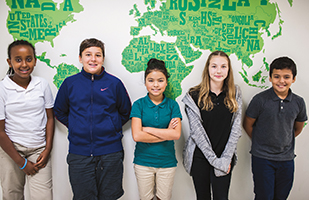
Global Competence in Schools
Systemic leadership practices to prepare students for diversity and interconnectedness in the world around them
BY ARIEL TICHNOR-WAGNER/
School Administrator, January 2019

|
Ariel Tichnor-Wagner
|
In a geographically isolated and economically struggling rural school district in eastern North Carolina, kindergartners through high school seniors are making their mark on the world.
Three years ago, I had the pleasure of spending time in Edgecombe County Public Schools to understand how district leaders, principals and teachers incorporated global competence into curriculum and instruction for all students.
Early elementary school students enrolled in a dual immersion program spoke Spanish to one another as they walked down hallways decorated with murals of continents and flags from around the world. Sixth-graders debated proposals they developed for how their school could reduce its carbon footprint. High school juniors used Skype to connect with a graduate of their school working for the U.S. Agency for International Development in Rwanda, a conversation that yielded insights about life a continent away and how their career choices could have a global impact.
Edgecombe County‘s global education initiative addressed much more than stagnant student achievement scores. It opened students’ eyes to possibilities they never imagined existed while priming them for success in college, careers and civic life.
No matter where our feet are planted, our students and schools are inextricably connected with the rest of the world. When students graduate high school and college, they will compete for jobs in a global marketplace and work with colleagues and customers from around the world. Most are already digitally connected to global networks through social media, apps, gaming and more. Our communities and classrooms are becoming more culturally and linguistically diverse, and challenges that impact local communities — from disease to violent extremism to climate change — require solutions that transcend borders.
For all of these reasons, global competence is a must-have for every staff member and student.
A Working Definition
Global competence is the knowledge, skills and dispositions needed to thrive in a diverse, interconnected world. Various organizations have developed frameworks that define global competence for students and teachers (see additional resources below). All coalesce around key attributes: empathy, valuing multiple perspectives, appreciating diversity, critical thinking, problem solving, an understanding of global conditions, events and interconnectedness, and cross-cultural communication and collaboration.
To instill global competence in students requires an instructional shift in how learning takes place in classrooms and schools — from traditional transmission of knowledge through lectures, textbooks and worksheets to the co-construction of knowledge using the real world as curriculum.
Embedding global competence as a learning outcome requires a systemwide approach that has the backing of school and district leaders. Yet up until this point, little work had addressed how educational leaders can best prepare students to thrive in a diverse, interconnected world.
Seven Tenets
By examining research and best practices of educational leaders committed to this work, ASCD and the Longview Foundation developed a framework for globally competent educational leadership. The framework includes seven globally competent leadership tenets centered around four leadership domains: vision setting, pedagogy and practice, situated action, and systems and structures. They are intentionally aligned to the Professional Standards for Educational Leaders, adopted in 2015 by the National Policy Board for Educational Administration, as globally competent leadership is integral to best leadership practices, not an add-on.
The seven tenets apply to leaders in districts large and small, from affluent suburbs to urban centers to rural communities. The examples below are drawn from interviews with more than 20 district and school administrators nationwide.
» Tenet 1: Facilitating and enacting a shared mission and vision of high-quality education that includes preparing students for life, work and citizenship in a global society.
Bring stakeholders together to collectively define global learning, determine how to implement it and connect it to local needs and priorities. A school principal in the District of Columbia, prior to starting a global studies program, conducted meetings with students, parents and community activists to incorporate their perspectives into the school’s definition of global competence. Other districts and schools have created global task forces with multiple stakeholders to articulate a global vision and oversee its implementation.
» Tenet 2: Implementing and supporting curriculum, instruction and assessment that incorporates global competence.
Give teachers the time, space and training to rework lessons, units and projects to incorporate a global perspective and build into the schedule new global classes and programs (such as global studies electives, Mandarin language lessons, dual immersion programs and global project fairs). District administrators can further support these efforts by clearing teachers’ professional development plates to focus on integrating global competence into their content area and by funding curricular resources.
» Tenet 3: Fostering a professional community where school personnel work together to build capacity around developing global competence.
Create opportunities for staff to lead collaborative work around global competence. In some districts, this has been addressed through monthly morning collaboratives, daily common planning time or cadres of mentor teachers and professional learning teams with staff from different content areas or grade levels. Some site leaders give staff the autonomy to control the global topics and projects pursued. As one middle school principal in a suburban Massachusetts district shared, “You have to let teachers experiment and decide how they incorporate global competence. You’re the gardener that lets it grow. … Sometimes you have to prune and scaffold so that their ideas will end up successful and sustainable in the long run.”

|
The Carlos Rosario International Public Charter School in Washington, D.C., attracts students from around the world.
|
» Tenet 4: Connecting and collaborating globally to promote global competence development.
Build a global professional learning community of local, national and international colleagues to augment students’ and staff’s global learning. Edgecombe County, N.C., sent groups of principals to observe schools in a neighboring district with similar demographics that already had a global initiative in place. Another mid-sized school district in the Southeast paid for administrators to attend international study programs to cultivate a global mindset and to make connections for school partnerships. Social media also has a powerful role in building virtual global professional learning networks without having to leave the office or break your budget.
» Tenet 5: Advocating for global competence and engaging families, community members and policymakers for support.
District leaders promote the importance of global learning to key stakeholders, including school board members and policymakers. They use the experience of families and community organizations as global learning partners. In some districts, parents have served as guest speakers or guests of honor at events showcasing students’ global work, and local businesses have sponsored global programs. Administrators have partnered with local universities and nonprofits in teacher exchange and professional development programs.
» Tenet 6: Striving for equity of access to high-quality global learning opportunities and cultivating an inclusive, caring and supportive school community that values the cultural and linguistic diversity of each student.
Recognize that global competence is a must-have for all students, regardless of ability level, disability, language proficiency or background. To achieve this, administrators in urban and high-need rural communities have required all teachers to participate in professional development on integrating global content across the curriculum. A Massachusetts high school principal whose school started a global citizenship certificate program intentionally did not make GPA a factor in the application process.
With schools serving as microcosms of a community’s global diversity, they accommodate the needs of students, families and staff from culturally and linguistically diverse backgrounds and spread an ethos of tolerance and civility so that all students, families and staff feel safe expressing their beliefs.
» Tenet 7: Managing school operations and resources to support global competence development.
Re-allocate existing resources, seek new resources through grants and partnerships and revise policies to support global learning. Districts have re-organized central-office positions to make global education implementation an explicit job responsibility. Districts also have used federal Title I and Title II funds to support global learning, sometimes by hiring instructional coaches focused on global project-based learning or by funding outside training.
Notably, globally supportive administrators emphasize that integrating global competence isn’t expensive. It’s about creating time in the schedule and prioritizing global learning when determining how professional development and personnel budgets will be used.
Getting Started
Leaders can incorporate these tenets into practice in the following ways.
» FIND YOUR WHY. Understanding the wider world begins at home. School leaders embrace global education for different purposes based on local needs. Some whose schools serve students hailing from across the world see global education as a way to create an inclusive school environment. Others see this as an equity issue to ensure all graduates are prepared to compete in a global economy. Grounding the global focus in local concerns can motivate you — along with teachers, parents and students — to embrace global learning.
» REACH OUT. Whether developing a globally focused mission statement or planning global professional development, don’t go at it alone. Create committees, bring content experts in or search online for existing courses, microcredentials or training to help teachers develop appropriate teaching practices. And administrators ought not be afraid to learn with and from students and staff by participating in educator exchanges or chaperoning an international student trip.
» GIVE YOURSELF TIME. This is an ongoing learning journey. Systems don’t change overnight. Districts that have implemented global learning initiatives have taken a year of planning time to gather support or have chosen to start with a small cohort of teachers before scaling up across the district.
No single prescription will lead to globally competent leadership. Much depends on local context and comfort level. But the time to begin is now. The world is waiting.
ARIEL TICHNOR-WAGNER is senior fellow of global competence at ASCD in Alexandria, Va. Twitter:
@atichnorwagner
Additional Resources
These informational resources include frameworks that define global competence and provide practical tips for leading global initiatives in schools and classrooms.
» “
Building Global Schools Toolkit,” Primary Source.
» “
Educating for Global Competence: Preparing Our Youth to Engage the World” by Veronica Boix Mansilla and Tony Jackson, Council of Chief State School Officers and Asia Society.
» “
Global Citizenship Education: Topics and Learning Objectives,” UNESCO.
» “
Globally Competent Educational Leadership: A Framework for Leading Schools in a Diverse Interconnected World” by Ariel Tichnor-Wagner and Jennifer Manise, ASCD and the Longview Foundation.
» “
The Globally Competent Learning Continuum” by J. Montana Cain, Jocelyn Glazier, Hillary Parkhouse and Ariel Tichnor-Wagner, ASCD.
» “
Preparing Our Youth for an Inclusive and Sustainable World: The OECD PISA Global Competence Framework,” Organisation for Economic Cooperative Development.